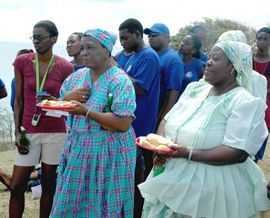Garifunas head back to Balliceaux

On Saturday, March 31, 2007 a contingent of more than ninety persons representing various organizations made the annual pilgrimage to the island of Balliceaux. The event was organized by the Ministry of Culture to culminate the month of activities held in commemoration of National Heritage and Heroes Month. The pilgrimage to Balliceaux has been held each year to pay tribute to the memory of the hundreds of Garifuna who lost their lives on the island, where they were marooned by the British in-transit to British Honduras in 1797.{{more}}
Led by Minister of Culture René Baptiste, the party left the Cruise Ship Terminal at about 10: 00 a.m. to make the eleven-mile journey to Balliceaux, a small picturesque and uninhabited island situated east of Bequia. Among those making the pilgrimage this year were members of Urawani Dance Group of Belize; representatives of the Chatoyer Youth Movement; students representing the Bethel High School, Barrouallie Secondary School and Community College heritage clubs; members of the media and several other persons.
While on Balliceaux, the group participated in a short and solemn ceremony paying homage to those who lost their lives on the island. There was the ceremonial lighting of the gums by members of the Chatoyer Youth Movement. This flame was lit to symbolize the soulful presence of the hundreds of Garifunas who paid the ultimate sacrifice on the island. The Urawani Dance Group led all present in performing a sacred ritual known as the Mali. This involved drumming chanting and dancing around the flame of the gums along with the food and drink placed as an offering to the souls of the departed that remain on Balliceaux. The ritual ended with the singing of a number of traditional hymns and choruses including Kumbaya.
In making her remarks, René Baptiste reminded the gathering about the reasons for conducting the pilgrimage. She pointed to the near genocide committed by the British over 200 years ago on the Garifuna people of St. Vincent. She noted that the present generation must never forget and implored the gathering to reflect on what it must have been like to attempt to survive on an island like Balliceaux in the late ninetieth century. The Minister also emphasized the government’s commitment to preserving the memory of the Garifunas’ struggle through the annual pilgrimage and to erect a lasting and fitting monument on the island. She also issued a call to other groups, organizations and individual to follow the lead of the government in organizing similar activities in memory of a dark period in the nation’s history.
The Garifunas are remembered for the epic struggle the waged against British attempts to deprive them of their land late 18th century. They were finally defeated in 1796. About 4, 339 of them were rounded up and exiled to the tiny island of Balliceaux for about seven months. Some 2, 248 survived Balliceaux and were exiled to Rotan an island off British Honduras, now Belize in March of 1797. In spite of all this, the Garifuna people and their culture have survived and continue to flourish. The annual pilgrimage to Balliceaux has been organized to honour all those who lost their lives on that island in defence of their homeland.









